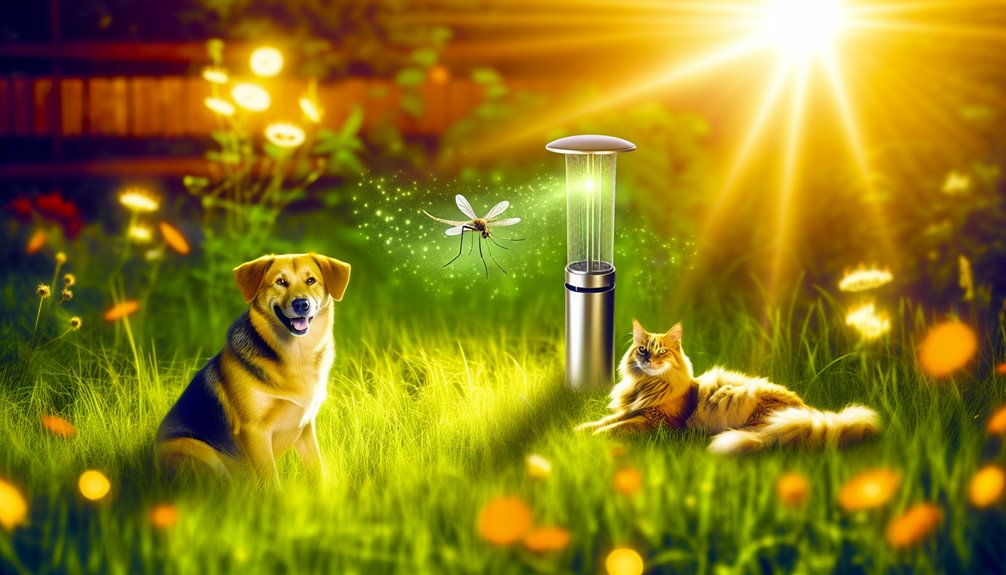Like a moat around a castle, effective mosquito control shields your pets from vectors that transmit heartworm, West Nile virus, and encephalitides. You reduce risk by eliminating standing water, using EPA-registered repellents, and maintaining vet-prescribed macrocyclic lactone preventives. Monitor for cough, exercise intolerance, neurologic signs, or fever—early detection changes outcomes. Weather-driven surges in vector activity demand seasonal adjustments. If you want a concise, science-backed plan that prioritizes safety and efficacy, here’s what to implement next.
Why Mosquitoes Are More Than a Nuisance for Pets

Although they seem trivial, mosquitoes are competent vectors that transmit pathogenic organisms to pets, driving morbidity that far exceeds skin irritation. You’re not managing mere annoyance; you’re mitigating vector-borne disease risk. Evidence links mosquito behavior—crepuscular feeding, host-seeking via CO2 and heat—to increased exposure in outdoor animals. Consequences include hypersensitivity dermatitis, secondary bacterial infections, and vector-associated pathogens that precipitate anemia, systemic inflammation, and cardiopulmonary compromise. Your stewardship of pet safety prioritizes surveillance, repellency, and environmental control to reduce vector-host contact. By anticipating seasonal abundance and habitat suitability, you interrupt exposure windows, protect vulnerable species, and uphold welfare standards grounded in preventive medicine.
How Mosquitoes Transmit Diseases to Dogs, Cats, and Outdoor Animals
How exactly do mosquitoes move pathogens into your animals’ bodies? During probing, the female’s stylets penetrate dermal microvasculature, and saliva—rich in anticoagulants and immunomodulators—enters first. If infected, virions or microfilariae in saliva bypass epidermal barriers, establishing local replication or hematogenous dissemination. Vector competence depends on the mosquito lifecycle: ingested pathogens must survive the midgut, escape into hemolymph, and invade salivary glands.
You reduce risk by interrupting transmission patterns. Pathogen load rises when host density, humid microclimates, and crepuscular feeding align. Short, frequent bites enable efficient inoculation; partial feeds across multiple animals amplify spread, especially when extrinsic incubation matches warm ambient temperatures.
Common Mosquito-Borne Diseases Affecting Pets

Understanding the mechanics of saliva-borne inoculation sets the stage for the diseases you actually need to watch for in outdoor pets. You’ll encounter heartworm disease (Dirofilaria immitis), transmitted by multiple Culex and Aedes vectors; larvae migrate to the pulmonary vasculature, causing endothelial injury, pulmonary hypertension, and right-sided cardiac strain. West Nile virus exposure in dogs and cats is uncommon but possible; mosquitoes act as biological vectors from avian reservoirs, with neuroinvasive potential. Eastern and Western equine encephalitis viruses threaten horses via bridge vectors, producing vasculitis and encephalomyelitis. Zika- and dengue-like arboviruses remain rare in pets but warrant surveillance in endemic zones.
Early Warning Signs and Symptoms to Watch For
Because incubation and target organs differ by pathogen, you should track system-specific sentinel signs that map to likely vector-borne disease. Prioritize symptom awareness and disciplined health monitoring. For heartworm, note exercise intolerance, soft cough, tachypnea, syncope, ascites, or jugular distension. For West Nile or EEE, watch acute ataxia, head tilt, hyperesthesia, tremors, seizures, or cranial nerve deficits. For dengue-like syndromes in dogs, monitor fever, lethargy, mucosal petechiae, epistaxis, melena, or thrombocytopenia. For allergic hypersensitivity to bites, identify pruritus, urticaria, or facial edema. Record onset, duration, and progression; capture resting respiratory rate and temperature. Escalate to veterinary evaluation promptly.
Yard Strategies: Eliminating Breeding Sites and Standing Water

With a vector-control mindset, you’ll disrupt the mosquito life cycle by removing any receptacles that accumulate water and by altering microhabitats that sustain larvae. Apply breeding site identification and water source management to reduce vector density and pathogen transmission risk to pets. Prioritize source reduction over chemical inputs to protect beneficial species and groundwater.
- Inspect gutters, drip trays, toys, tarps, and planters; dump and scrub weekly to break egg adhesion and biofilm that supports larvae.
- Regrade depressions, aerate compacted soil, and maintain drains to prevent pooling.
- Cover rain barrels with 1-mm mesh; refresh birdbaths every 48 hours; chlorinate pet-inaccessible ornamental pools appropriately.
Safe and Effective Mosquito Repellents and Vet-Recommended Protectants
Although source reduction lowers vector pressure, you still need topical and systemic protectants to reduce mosquito bites and arbovirus exposure in pets. You’ll prioritize efficacy against vectors transmitting heartworm, West Nile, and EEEV. Choose vet approved products containing permethrin (dogs only), deltamethrin, or flumethrin collars; combine with isoxazoline or macrocyclic lactone preventives for systemic coverage. For cats, use feline-safe imidacloprid/flumethrin collars or selamectin-sarolaner spot-ons. Validate label claims, duration, and repellency (anti-feeding) versus mere knockdown. Natural repellents like lemon eucalyptus or neem offer short-lived protection; never apply undiluted oils. Monitor for hypersensitivity, avoid pyrethroids in cats, and maintain dosing intervals.
Seasonal and Weather-Based Mosquito Control Plans
As temperatures, rainfall, and humidity shift across seasons, you’ll adjust mosquito control to match vector phenology and biting intensity. Align interventions with weather patterns that drive oviposition, larval development, and host-seeking. Prioritize heartworm prevention continuity, then modulate environmental suppression and exposure reduction using seasonal treatments grounded in surveillance data.
1) Spring: After rains, drain containers, clean gutters, deploy larvicides in cryptic water; schedule dusk curfews to reduce West Nile and heartworm transmission windows.
2) Summer: During heat waves, intensify residual barrier sprays and fan use; irrigate early to avoid puddling.
3) Fall: Target late broods; repair screens, overwinter-proof yards, maintain prophylaxis.
When to Call a Professional for Mosquito Management Around Pets
If mosquito pressure exceeds your threshold despite source reduction, pet-safe repellents, and consistent heartworm prophylaxis, escalate to a licensed vector-control professional. You’ll know when to call if bite indices persist, larval habitats are inaccessible, or you suspect vector-borne pathogens (e.g., Dirofilaria immitis, West Nile virus, EEEV). Professionals conduct surveillance (larval dipping, adult trapping), identify species, and implement integrated pest control: larvicides (Bti, methoprene), targeted adulticides, residual barrier treatments, and habitat remediation. Insist on pet-safe formulations, label compliance, and resistance management. Seek help after flood events, irrigation failures, or construction. Document outcomes, reassess risk, and coordinate with your veterinarian.
Conclusion
As the proud owner of Mosquito Eliminators of South MS, I truly understand the importance of keeping our beloved pets safe from the dangers of mosquito-borne diseases. It’s a commitment that goes beyond just prevention; it’s about ensuring that our furry friends can enjoy the outdoors without worry. By taking proactive steps like eliminating standing water and using EPA-registered repellents, we can create a safer environment for them. If you’re interested in learning more about how we can help protect your pets and your family, I invite you to visit us at mosquitoeliminatorsms.com or give us a call at (601) 336-2277. Together, we can make your outdoor spaces enjoyable and safe!

